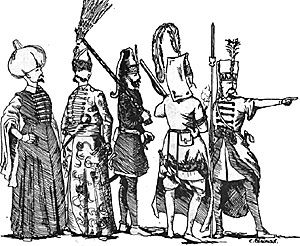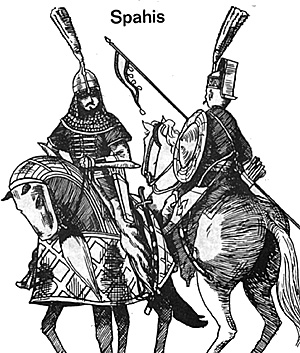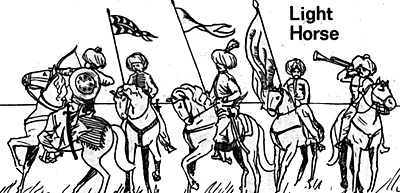The Janissaries, first formed by the Sultan Murad in about 1360, were the world's first regular standing infantry force, and the core of the Turkish army until 1826. Originally they were recruited from the children of Christians living within the bounds of the ottoman Empire: all those who had attained the age of 7 years were subject to inspection.
The most promising youths were removed to serve a period of apprenticeship, before being enrolled as "yeni-cheri" or "new troops".
At first 1,000 were recruited each year, to be brought up in special places of instruction, subject to the severest military and religious disciplines; they were almost an eastern counterpart of the fighting monks of the western orders of the Hospital and the Temple. The Janissaries were not allowed to marry; they were to abstain from luxury, extravagance and practices unseemly for soldiers and brave men; they were to observe strict religious law, and to allow into the ranks none except those who had been properly levied. Many of these regulations were soon infringed, particularly the last, for the privileges attached to membership of the corps meant that parents were soon begging to have their children enrolled. At first recruits were limited to the children and relatives of former Janissaries, but later the whole system was relaxed, and anyone was allowed to join, only negroes being barred.
Equipment
In times of peace, the Janissaries were allowed to carry only swords and club unless they were serving at frontier posts, and they received no pay. As a result the regulation forbidding them to engage in trade was quickly forgotten and betwee:' campaigns they earned their bread like ordinary civilians. On campaign, the Janissaries carried scimitar, lance, dagger and bow, or later an arquebus or musket. Some sources also suggest a round shield. A powder horn was slung on the right side, if a matchlock was carried, with a length of match coiled round the left arm, ready to use. With regard to musketry, the Turkish weapon "7 to 9 palms long" was used with great accuracy by the Janissaries; many were the instances during the siege of Malt: in 1565 in which their firing outclassed that of the defenders by a long way. When the time for the charge came, the Janissary soldier would sling his musket across his back and use his sword or dagger. Some variety in descriptions of the weaponry they carried can be attributed to the fact that the individual soldier had to provide his own, and equipment could well have varied greatly from man to man.
 Uniforms
Uniforms
The dress of the Janissaries: most sources agree upon the subject of headgear the tall white
cap with the long trailing sleeve hanging down the back. Round the base of the hat there was a
design worked in gold (whether this was actually metal or merely an embroidered design is not
apparent). What may at one time have been a nose-guard served as an attachment for holding the tall heron plume, seen on the second figure from the right in the illustration. According to most information this plume was not worn in battle. The long tail of the cap was a reminder of the time when the Saint Haji Bektash, founder of the Bektashi dervishes, blessed the corps at its inception by laying the long white sleeve of his coat across the he a: of the Aga of Janissaries. The two figures are taken from R. Knotell's "Heere der Vergangenheit" series, and
originally came from sixteenth century works on contemporary
costume. Both men wear the long overgarment, variously referred to as
a caftan or spahi, which was made of silk. To facilitate movement, the long skirts were often tucked up into the belt or sash at the waist, either at the front or the back. Sources vary as to whether this garment was light blue for the whole corps or whether many different colours were worn. Certainly a coloured print dated 1577 (Weigel's book on dress) shows it as being green, and it may be that some time after this date a uniform colour was introduced.
The officer, second from the left, is taken from Toman. Senior officers (beuluks) wore red boots, the others yellow; those of subordinate officers were black. The character on the left is an Aga (Commanderin-Chief) of the Janissaries. The figure is taken from Larousse's "Dictionnaire Encyclopedique" (1929 edition) which might seem a way out source, but it is the only illustration of an Aga I have found anywhere. The same source shows a Janissary soldier, devoid of the caftan and wearing only the short tunic, as in the centre figure in my drawing.
The man in my sketch in fact comes from a Turkish work, the "Nusretname", which describes the conquest of Georgia, in 1578. Janissaries are shown occupying the city of Tiflis, captured by Lala Mustafa Pasha, and they are all wearing this costume, in varying colours. Another point worth noting is that all the stocks of their muskets are inlaid with patterns.
Until 1574, the corps numbered only 20,000 men, but with the slackening off of admission regulations this increased to 48,688. The Sultan Ibrahim (1640-8) reduced the number to 17,000, but from his reign onwards they increased steadily till in 1826 they numbered 135,000. The whole corps (ojak) was divided into smaller units (ortas). Each orta had a flag, half yellow, half red, while the banner of the ojak was of white silk, with verses from the Koran embroidered upon it in gold. Each orta also had several large cauldrons, used for boiling soup. If these were lost to the enemy, all the officers of the unit were disgraced.
Like the Roman Praetbrian Guard and the Russian Strelitz, the Janissaries proved as much trouble to their rulers as to the enemies of the Grande Porte. As their numbers swelled, their turbulence grew, and dissatisfaction with the regime sent them rampaging through the streets of Constantinople, pillaging and burning. In the 28 years of Ahmed III's reign, they set fire to the city 140 times; Sultans remained in power just as long as the Janissaries were content with them.
At the beginning of the 19th century several attempts were made to suppress the Janissaries and replace them with a new body of regular infantry. These attempts failed until the Janissary riot of 1826, when troops loyal to the Sultan surrounded the insurgents in El Meidan square, Constantinople. War was formally declared against them, but the Janissaries refused to yield even when artillery was brought up to rake the square. In the bloodbath which followed, the Sultan's troops slaughtered the entire corps of Janissaries, burning down the barracks where the survivors took refuge and hanging all the prisoners they took. So ended the warriors who boasted that "the body of a Janissary is only a stepping stone for his brethren into the breach itself.
 The Spahis
The Spahis
The Spahis were the standing regular cavalry of the Ottoman Empire. The word
comes from the Persian "siparhi" meaning warrior (synonymous with sepoy) and designated the holders of fiefs in central Asia who yielded personal military service to their superiors. In
Turkey a similar system prevailed, the land being divided into several categories. Vakuf-land provided revenues for the upkeep of public buildings and institutions; yurtluk-ojaklik lands were the frontier districts, and revenues went towards defence; timar, ziamet and khas lands were regions where the revenues were 2,000 - 20,000 aspres, 20,000 - 100,000 aspres and over 100,000 aspres respectively and these were held either by state officials or as hereditary fiefs by the Spahi, the feudal nobility of Turkey.
When he went to war, the spahi had to bring with him contingents of infantry, cavalry and naval troops from his territory. He himself went into battle riding a magnificent steed, and wielding the best weapons the armourers of Turkey could provide: lance, scimitar, bow, axe, hammer, mace and boar-spear; firearms were also carried. The man on the right in the sketch carries the round cane shield that was made of willow or fig tree branches, bound in concentric rings with wool, silk or gold thread, with a steel boss in the centre. From about the 17th century on, it is likely that the increasing use of firearms made all-steel shields more popular.
The heavy-looking character on the left wears the typical helmet of the 16th and 17th centuries. It was bowl shaped, with a metal spike in the centre (hidden behind plume in the picture) and a plume holder/nose guard at the front. The aventail (curtain) of chain mail hung down to the shoulders at the sides and back and low over the eyes at the front. Plate armour was never popular in the east, due to the climate, and mail was more frequently worn.
The most common form of body armor was the Persian "char aina" or four mirrors, consisting of a large breastplate, a back plate and two smaller ones that fitted beneath the armpits at either side. The figure in the picture wears only mail protection except for the bazubands or vamb aces on his forearms, pieces of plate armour extending to points to defend the elbow.
The first troops of Spahis carried a yellow standard, the second red, the third red and white, fourth white and yellow, fifth green and white.
 LIGHT CAVALRY
LIGHT CAVALRY
A large part of the Turkish army in the field was always irregular light horse. Unlike the west, where the advance guard was a position of honour, eastern bat t le fields saw the Turkish vanguard as a swarm of mounted Kurdst Tartars and feudal levies, who pushed ahead of the main army, pillaging and devastating. Fighting with bow, sabre and lance, these troops were unequalled in irregular warfare, save by the excellent Hungarian hussars.
The re-curved composite bow of the Turks, who made some of the best ever fashioned, was capable of shooting light arrows great distances, and could easily be fired from horseback. It was made of horn and wood, covered with birch bark and then lacquered and decorated. The scimitars carried by these troops, the curved, single-edged blade so often associated with eastern warfare, first appeared at the end of the 14th century, superseding the straight, double-edged weapon of the Saracens. At first the curvature of the blade was slight, but by the 16th century it had evolved to the shape it would retain, virtually unchanged, until the 19th. When used, it did not rely upon weight of stroke, or upon use of the point, but upon a motion of the arm that drew the entire length of the blade across the object being struck.
The Janissaries Part 1: History, Uniforms, and Tactics [114]
Back to Table of Contents -- Wargamer's Newsletter # 113
To Wargamer's Newsletter List of Issues
To MagWeb Master Magazine List
© Copyright 1971 by Donald Featherstone.
This article appears in MagWeb.com (Magazine Web) on the Internet World Wide Web.
Other articles from military history and related magazines are available at http://www.magweb.com